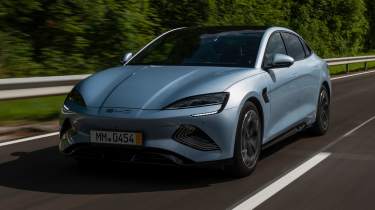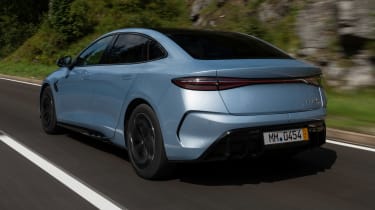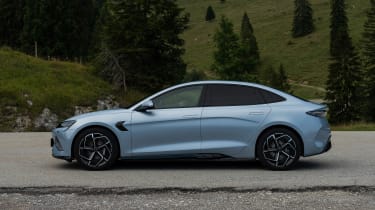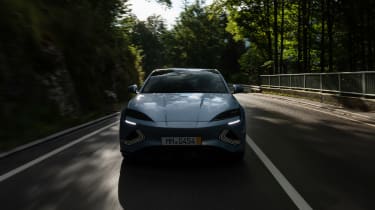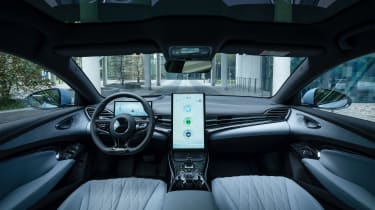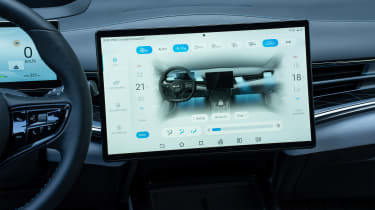BYD Seal 2023 review
The all-electric BYD Seal offers punchy performance, range and an abundance of tech, but intrusive assistance systems will be a sticking point for many
Just a year since BYD launched in Europe, it has given us the mid-sized Seal saloon, targeting the likes of the BMW i4 and class-leading Tesla Model 3. While the UK market has only just been exposed to the Chinese brand, it has spent almost three decades developing battery technology for various applications, making it well equipped for the task at hand. The marque sold 1.86m cars last year making it China’s largest automotive brand, and there’s even a good chance you already own one of its products; its technology division manufactures the Apple iPad. While it’s clear that BYD can manufacture a solid piece of tech, the Seal will prove just how well this expertise transfers to the production of a performance car.
Built on an all-new platform, the Seal features an 82.5kWh battery pack constructed from 172 blade-like cells, with each of these mounted directly to the car body to eliminate wasted space. Not only does this allow for a bigger battery, it also contributes to high rigidity, improving structural safety and reducing front and rear overhangs in turn – this also allowed for a lower drag coefficient, with the Seal’s Cd at 0.219 to the Tesla Model 3’s 0.23. With so much battery expertise under its belt, even BYD’s arch rival Tesla is now using its batteries in Berlin-produced Model Ys…
> BMW i4 M50 review – has BMW picked off the Tesla Model 3 first time around?
At launch, the Seal is available in two trim levels: the single-motor, rear-wheel drive Design, and dual-motor, all-wheel drive Excellence. Aside from the absence of a head-up display and adaptive dampers in the rear-wheel drive variant, the only difference between them is in the powertrain; both share the same battery pack, 19-inch wheels, full-length panoramic sunroof and 12-speaker Dynaudio sound system as standard. A lesser Comfort trim with a smaller battery will come at a later date, but details are still under wraps.
First impressions are strong, and while the Seal’s front-end design does bear a striking resemblance to the Hyundai Ioniq 6, its design is attractive, if a little generic. A full width light bar can be found at the rear, with unique front daytime running lights making it recognisable out on the road. Flush door handles are equipped for aerodynamics, but unlike some, they feel reassuringly solid, with a simple lever-style mechanism. Following customer feedback, BYD will also sell all European cars without Build Your Dreams lettering on the rear, which is a relief.
Inside, the Seal is smaller than you might expect, with various interior elements sitting close, but this is far from a deal-breaker providing you don’t often travel four-up – rear leg room is more than enough for the average adult, but there’s no room for feet under the front seats. The full-length sunroof does provide the illusion of more cabin space, though, with the floating centre console adding some handy additional storage.
Interior design is contemporary, with leather, an Alcantara-alternative and contrast stitching giving it a premium feel. Hard plastics aren’t hard to find, but strong build quality makes this less of an issue, with overall feel on par with the likes of Hyundai. The folding mirrors on our particular test car did occasionally make a concerning creaking sound while folding, but fit and finish is strong overall.
Thumb the crystal drive selector to Drive, and the Seal rolls away not in silence, but playing a tune you’d typically expect from an ice cream van. As with many EVs, the Seal plays an exterior pedestrian safety sound at below 19mph, but this is a particularly obnoxious one that certainly draws some eyes through town.
Out of town, though, the Seal’s excellent low-mid speed refinement becomes apparent, with elements such as double-layer front windows making it a quiet place to be. On the motorway, wind noise is certainly present and louder than some European rivals, but with no creaking, rattling and excess tyre roar, the Seal is well refined.
Getting from standstill to motorway speeds doesn’t take long either, with the all-wheel drive Excellence model claiming a 3.8sec 0-62mph time – it even features ‘3.8s’ badging at the rear to remind you. Power stands at 523bhp and 494lb ft of torque, and while this is less than the BMW i40 M50 with 536bhp and 586lb ft, acceleration figures don’t suffer – though its top speed is 29mph higher than the Seal’s 112mph peak, the i4 M50 takes an extra tenth to reach 62mph from standstill.
Weighing 2185kg in its all-wheel drive configuration, it’s hardly lightweight, bringing power-to-weight ratio to 239bhp/ton (10bhp/ton down on the i4 M50). The single-motor Seal Design is lighter at 2055kg, with its 309bhp output making for a 150bhp/ton power-to-weight figure.
The all-wheel drive Seal doesn’t feel quite as spritely as you might expect from low speeds, and its weight is noticeable under acceleration. There’s no doubt it’s quick, but initial response isn’t as razor-sharp as we’ve seen from other EVs, with the throttle mapping softer even in its sharpest setting – on the move, there’s a noticeable delay in throttle input and response, too, but this is something you quickly get accustomed to. Our first drive in Germany saw us tackle a few stretches of derestricted autobahn, and the Seal reaches its 112mph limiter without much issue. As with most EVs, it does run out of strong pull at higher speeds, but this is rarely something you’ll need to make use of. While considerably less powerful, the lighter rear-wheel drive model still possesses solid straight-line performance, with overall performance not far from the range-topper in normal driving scenarios.
As standard, the all-wheel drive comes equipped with double wishbone front, five-link rear suspension with ‘semi-active’ adaptive dampers, but switching between modes doesn’t bring about much change in ride quality. On all but the smoothest roads, ride can be busy, while a relatively low spring rate makes for some unwanted body roll when you’re pushing on. Nevertheless, the Seal will cover ground quickly should you need it to, with its standard-fit 235-section (front and rear) Continental EcoContact tyres performing well enough on our sodden test drive.
Steering is refreshingly direct with very little in the way of off-centre slack, but as with most cars in 2023, it’s light and free of feel. Switch to Sport mode and it adds artificial heft, but we prefer the Seal in its Comfort steering setting for its more natural, linear feel.
The Seal’s brakes are easy to modulate and provide enough stopping power under ordinary road driving conditions to inspire some confidence, but they do lack an initial bite that some may prefer. Pedal feel is unusual when pushing on, with a clear step in the pedal presumably a result of the blend of regen and friction braking.
Speaking of regenerative braking, the Seal is an efficient machine, achieving 354 miles of WLTP range in rear-drive spec, a close match to the most efficient BMW i4 and Tesla Model 3 with 365 and 374 miles of range respectively. Opt for the range-topping all-wheel drive and this is knocked back to 323 miles. Disappointingly, the Seal can only accept 150kW DC charging, some way behind the Tesla Model 3’s 250kW peak.
Being the company responsible for the production of the iPad, it should come as no surprise that the Seal comes with a large tablet mounted to the dash. Mounted on an electric motor to allow for change of orientation on the move, the main infotainment display offers customisation for just about every element in the car, from whether the ambient lighting responds to music, to what noise the indicators make and which wallpaper the home page displays. While customisation can be great, the Seal takes this to the extreme, with bewildering, frustrating layers of settings making it an overwhelming system to operate – to exacerbate the situation, poor English translations also make it difficult to determine what each setting does, with our test car labelling torque vectoring as ‘intelligent Torture Adaption Control’…
While not an issue limited to the Seal, climate control settings are available only through the touchscreen, with even the vent direction adjusted electronically. Dual wireless chargers are nice to have, but our car saw the system repeatedly display a ‘device charging’ message while on the move, blocking navigation in the process. The driver assistance and safety systems are even more infuriating, with numerous systems constantly beeping and speaking at you – lane keep assist is also the most aggressive I’ve experienced, jerking the wheel seemingly at random on narrow roads. While these systems can be deactivated, it’s a process you need to undertake each time you start the car, which is something we’re not overly keen on.
Price and rivals
As a direct rival to the likes of the BMW i4, Hyundai Ioniq 6 and Tesla Model 3, the BYD Seal has some stiff competition. Although it lacks the dynamic edge and refinement of some offerings, and comes equipped with some irritating driver assistance systems, the Seal's competitive £44,990 starting price will be enough for some to turn a blind eye to its faults. Even more impressive, though, is the £47,990 price tag of the dual-motor Excellence.
Closest in numbers to the Seal range-topper is the £50,990 Tesla Model 3 Long Range, even though the Tesla's 0-62mph time is three tenths slower. The Model 3 Performance eclipses the Seal with a rapid 3.1sec sprint, but comes at a £10,000 premium to the BYD. For £54,040 you can have Hyundai's dual-motor Ioniq 6, and while range is near-identical to the Seal, a 5.1sec 0-62mph sprint puts it quite some way behind in performance terms. BMW's 537bhp i4 M50 comes closer with a similar WLTP range and 3.9sec 0-62mph time, but a £71,085 price tag puts it completely out of reach.
While buyers are unlikely to cross-shop Porsche and BYD, the Taycan 4S makes for an intriguing comparison, with an identical 523bhp output, a slower 4sec 0-62mph time and a price tag almost twice as high at £90,700. The Porsche offers considerably better refinement, materials, dynamics and design, but on sheer numbers alone, it doesn't outgun the Seal.
The recent 429bhp MG4 XPower has proven that big performance can be had at the lower end of the EV market, but the BYD Seal is the first to offer this in practical saloon-form and with respectable range. Those software issues will be a deal breaker for some, but if you can look past them, the Seal is an impressive EV package. With an even cheaper, more efficient variant to come, it's certainly one to watch.
BYD Seal Excellence (AWD) specs
| Powertrain | Dual motor, all-wheel drive |
| Power | 523bhp |
| Torque | 494lb ft |
| Weight | 2185kg |
| Power-to-weight | 239bhp/ton |
| 0-62mph | 3.8sec |
| Top speed | 112mph |
| Price | £47,990 (£44,990 RWD) |
